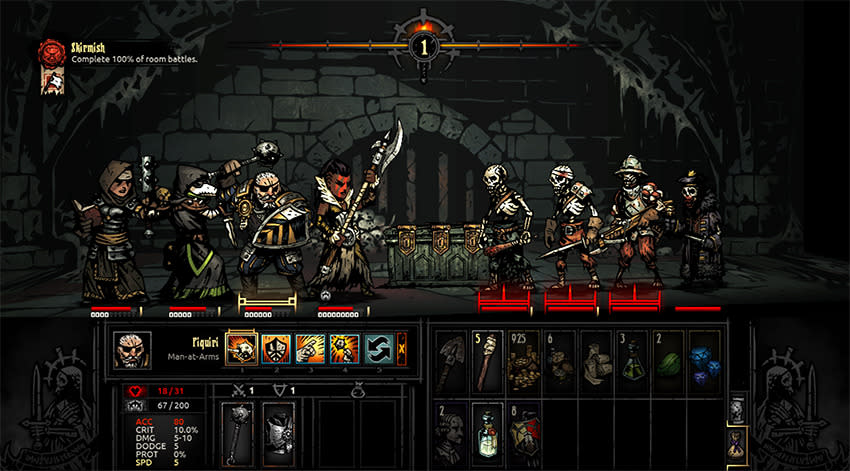Review: Harrowing ‘Darkest Dungeon’ Lets You Play With Madness

Fighting foul denizens in Darkest Dungeon. (Photo: Red Hook Studios)
Fantasy dungeons are, typically, unpleasant. They’re dark, smelly, and populated with abominations that want to kill you.
So it’s odd that most fantasy role-playing games feature parties of adventurers who uncomplainingly trudge through mile after mile of pungent sewage, swinging swords, and slinging fireballs until their last hit point is bled dry.
The makers of Darkest Dungeon have a different vision. This tactical RPG from indie developer Red Hook Studios, kickstarted in 2014 and just released after months of refinement on Steam Early Access, imagines parties of dungeoneers who feel mounting pressure until, one by one, they begin to crack under the strain. An expedition begun in optimism and camaraderie can end in selfishness, despair, and madness.
It’s a brilliant conceit, but the trick is in the execution. After all, if all you’ve done is turn morale or psychological stability into another hit-point counter, you haven’t really done anything at all. Darkest Dungeon doesn’t entirely avoid this trap, but its clever gameplay mechanics and formidable design will keep you trudging through dungeons for hours on end.
The psychological element is tracked by your party members’ stress level. Up to a point, stress is just like a shadow hit-point bar, vulnerable to its own array of enemy attacks and spells. But after a certain tipping point, your heroes will officially freak out and develop lousy new character traits like masochism, hopelessness, and selfishness.
These traits, in turn, trigger unpredictable character actions. A masochist might stab herself in the middle of battle; a selfish companion might grab all the loot in a treasure chest. Sometimes a party member will refuse a healing spell, or, despairing, simply pass his turn altogether. You’re not fully in control, and the higher the stress mounts, the more your protagonists develop twisted minds of their own.
Darkest Dungeon is tuned for gamers who like a challenge. Death is permanent — there are no resurrections or reloads — so you’ll need to manage a constant influx of new heroes in order to keep your dungeon-delving profitable. After a dungeon run, party members may be so stressed out that they’ll need to relax at a tavern or pray at an abbey for a week to recover their sanity. This dynamic creates a taut meta-game of trying to make sure the right characters are available at the right time for a particularly tough quest.
The seemingly straightforward four-versus-four tactical combat holds a surprising amount of depth. Character positioning is critical: All four stand in a line, and that order can make a huge difference. A party member may not be able to cast the same spell in the front as she can in the back. The various classes hold interesting strategic pros and cons too. My favorite is the jester, a nimble fighter who leaps around the battlefield, potentially unlocking powerful combos but occasionally messing up your party order in unexpected ways.
All of these mechanics are set into relief by first-rate art design. The characters and environments are rendered in gloomy drawings with just enough frames of animation to sell them. The style is gleefully Lovecraftian, at once creepy, witty, and unsettlingly funny. It sounds fantastic too. Stuart Chatwood’s music is suitably ominous, and voice-over artist Wayne June deserves special credit for his deep, Charlton Heston-esque rumblings as the ubiquitous narrator.
Darkest Dungeon stumbles a little in its interface, which initially feels needlessly complex and unintuitive. Obscure little icons litter the screen, but it’s not always obvious what they mean. The core mechanics could have done with some paring down too. Do there really need to be three different kinds of stress-relief buildings, each with multiple subdivisions? I’m still not sure what the difference is between the Cloister, the Transept, and the Penance Hall.
And although Darkest Dungeon becomes fiercely addictive, that feeling eventually wears thin. You tick off quests one by one, but it’s a long way to completion and few will have the patience to get there. There’s not much variety in enemy types, and the dungeons themselves are just abstracted strings of encounters.
But while it’s got its hooks into you, Darkest Dungeon exerts a powerful pull. Hear the chilling call of the foul, nameless catacombs, and dispatch your minions to their maw! They’ll be going mad, but you’ll be having a blast.

What’s Hot: Smart tactical combat, striking Lovecraftian style, innovative psychological gameplay
What’s Not: Messy interface, grows repetitive
You can email Gordon Cameron here.

